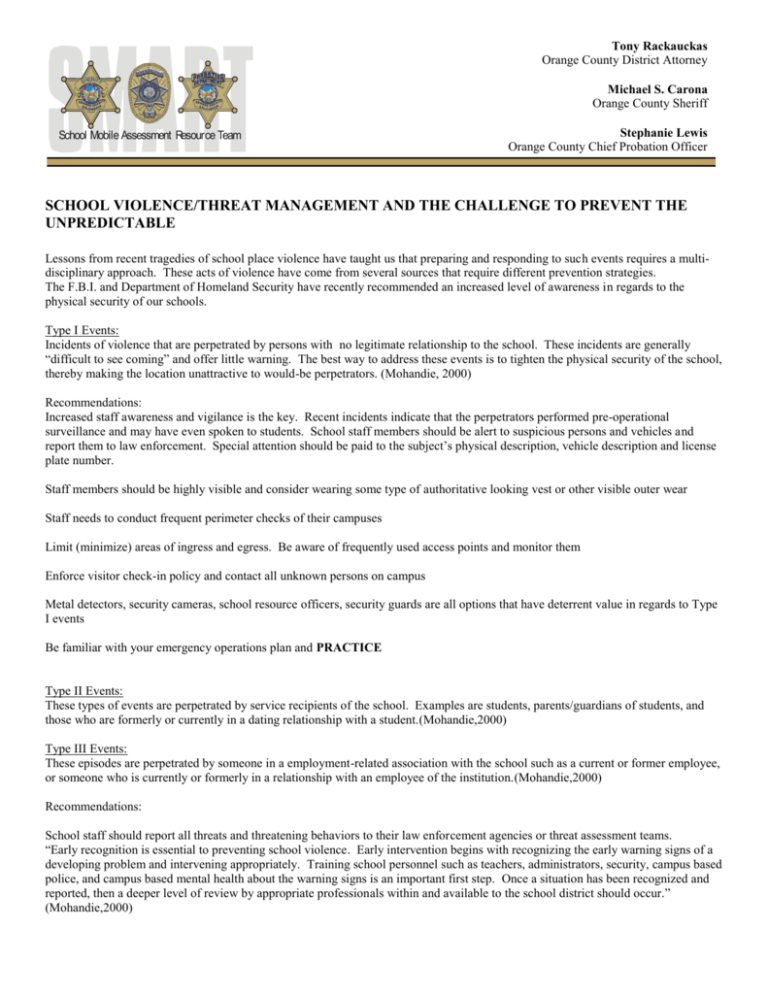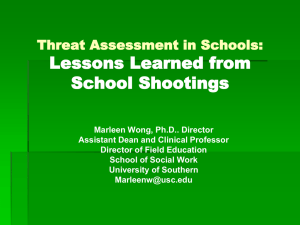SCHOOL VIOLENCE/THREAT MANAGEMENT AND THE
advertisement

Tony Rackauckas Orange County District Attorney I FF SHEAEL R OF T AL OF TH SE E GREAT TH TY CA Michael S. Carona Orange County Sheriff STAT E OF AN N GE COU E A OR STAT E OF FORNI E GREAT TH H E S CA LI L I FORNI A School Mobile Assessment Resource Team Stephanie Lewis Orange County Chief Probation Officer SCHOOL VIOLENCE/THREAT MANAGEMENT AND THE CHALLENGE TO PREVENT THE UNPREDICTABLE Lessons from recent tragedies of school place violence have taught us that preparing and responding to such events requires a multidisciplinary approach. These acts of violence have come from several sources that require different prevention strategies. The F.B.I. and Department of Homeland Security have recently recommended an increased level of awareness in regards to the physical security of our schools. Type I Events: Incidents of violence that are perpetrated by persons with no legitimate relationship to the school. These incidents are generally “difficult to see coming” and offer little warning. The best way to address these events is to tighten the physical security of the school, thereby making the location unattractive to would-be perpetrators. (Mohandie, 2000) Recommendations: Increased staff awareness and vigilance is the key. Recent incidents indicate that the perpetrators performed pre-operational surveillance and may have even spoken to students. School staff members should be alert to suspicious persons and vehicles and report them to law enforcement. Special attention should be paid to the subject’s physical description, vehicle description and license plate number. Staff members should be highly visible and consider wearing some type of authoritative looking vest or other visible outer wear Staff needs to conduct frequent perimeter checks of their campuses Limit (minimize) areas of ingress and egress. Be aware of frequently used access points and monitor them Enforce visitor check-in policy and contact all unknown persons on campus Metal detectors, security cameras, school resource officers, security guards are all options that have deterrent value in regards to Type I events Be familiar with your emergency operations plan and PRACTICE Type II Events: These types of events are perpetrated by service recipients of the school. Examples are students, parents/guardians of students, and those who are formerly or currently in a dating relationship with a student.(Mohandie,2000) Type III Events: These episodes are perpetrated by someone in a employment-related association with the school such as a current or former employee, or someone who is currently or formerly in a relationship with an employee of the institution.(Mohandie,2000) Recommendations: School staff should report all threats and threatening behaviors to their law enforcement agencies or threat assessment teams. “Early recognition is essential to preventing school violence. Early intervention begins with recognizing the early warning signs of a developing problem and intervening appropriately. Training school personnel such as teachers, administrators, security, campus based police, and campus based mental health about the warning signs is an important first step. Once a situation has been recognized and reported, then a deeper level of review by appropriate professionals within and available to the school district should occur.” (Mohandie,2000) 10 Myths About School Shootings 1) “He didn’t fit the profile” No profile exists for a student contemplating an act of targeted school violence. A study of past incidents indicated that shooters demographics, personality, school history, and social characteristics varied substantially. Attackers were of all races, family situations, and of academic achievement. 2) “He just snapped” Rarely are acts of targeted school violence sudden and impulsive. Most attackers go through a process that involves forming an idea, planning/preparation, and implementation. This time period provides an opportunity to observe warning signs and begin preemptive intervention. 3) “No one knew” Before most attacks, someone knew about the idea or the plan (usually kids). Most attackers engaged in some behavior prior to the incident that caused concern or indicated a need for help. 4) “He hadn’t threatened anyone” Too much emphasis is placed on threats. Most attackers did not threaten, and most of those who threaten, did not attack. A child who talks about bringing a gun to school has not made a threat, but poses a threat to school safety. 5) “He was a loner” In many cases, students were considered in the mainstream of the student population and were active in sports, school clubs or other activities. 6) “He was crazy” Only one-third of past attackers had ever been seen by a mental health professional, and only one-fifth had been diagnosed with a mental disorder. Substance abuse problems were also not prevalent. 7) “If only we had a SWAT team or metal detectors” Despite prompt law enforcement responses, most instances are over before police arrival at the location. Metal detectors have not deterred students who were committed to killing themselves and others. 8) “He’d never touched a gun” Most attackers had access to weapons and had used them prior to the attack 9) “We did everything we could to help him” Many attackers felt bullied, persecuted or injured by others prior to the attack, and said they had tried without success to get someone to intervene. Administrators and teacher are targeted in more than half of past incidents. 10) “School violence is rampant” It may seem so, with media attention focused on a spate of school shootings. The fact is that school shootings are extremely rare. The SCHOOL MOBILE ASSESSMENT and RESOURCE TEAM (S.M.A.R.T.), a detail operated and supervised through the Orange County Sheriffs Department, can be utilized in situations and incidents at schools related to violence, threats, possession and or use of weapons, bizarre and unstable behaviors, and suicidal related actions. The SMART unit works in conjunction with school officials, the probation department, the district attorney’s office, and mental health agencies to help resolve safety issues and concerns involving all personnel associated to each individual school. The unit provides services and resources, including threat assessment, criminal investigation, and referrals to counseling where deemed appropriate. The goal of SMART is to evaluate and assess each case individually, effectively resolve the matter through the least intrusive means available (while still maintaining safety and security to the school), and ultimately return the staff and students to their daily routine. Contact with SMART can be made at any time. Office (714) 569-3755 OCSD Dispatch (714) 647-1832/(949) 770-6011 Sources: Dr. Kris Mohanide, PH.D., School Violence Threat Management, 2000, SpecializedTraining Services, Threat Assessment in Schools, 2002, United States Secret Service and Unite States Department of Education US Attorney’s Office, Central District of Illinois Anti-Terrorism Advisory Council (ATAC) dated October 4, 2006 :










